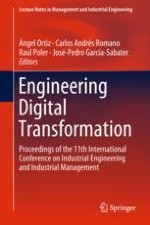2019 | Buch
Engineering Digital Transformation
Proceedings of the 11th International Conference on Industrial Engineering and Industrial Management
herausgegeben von: Ángel Ortiz, Carlos Andrés Romano, Raul Poler, José-Pedro García-Sabater
Verlag: Springer International Publishing
Buchreihe : Lecture Notes in Management and Industrial Engineering
